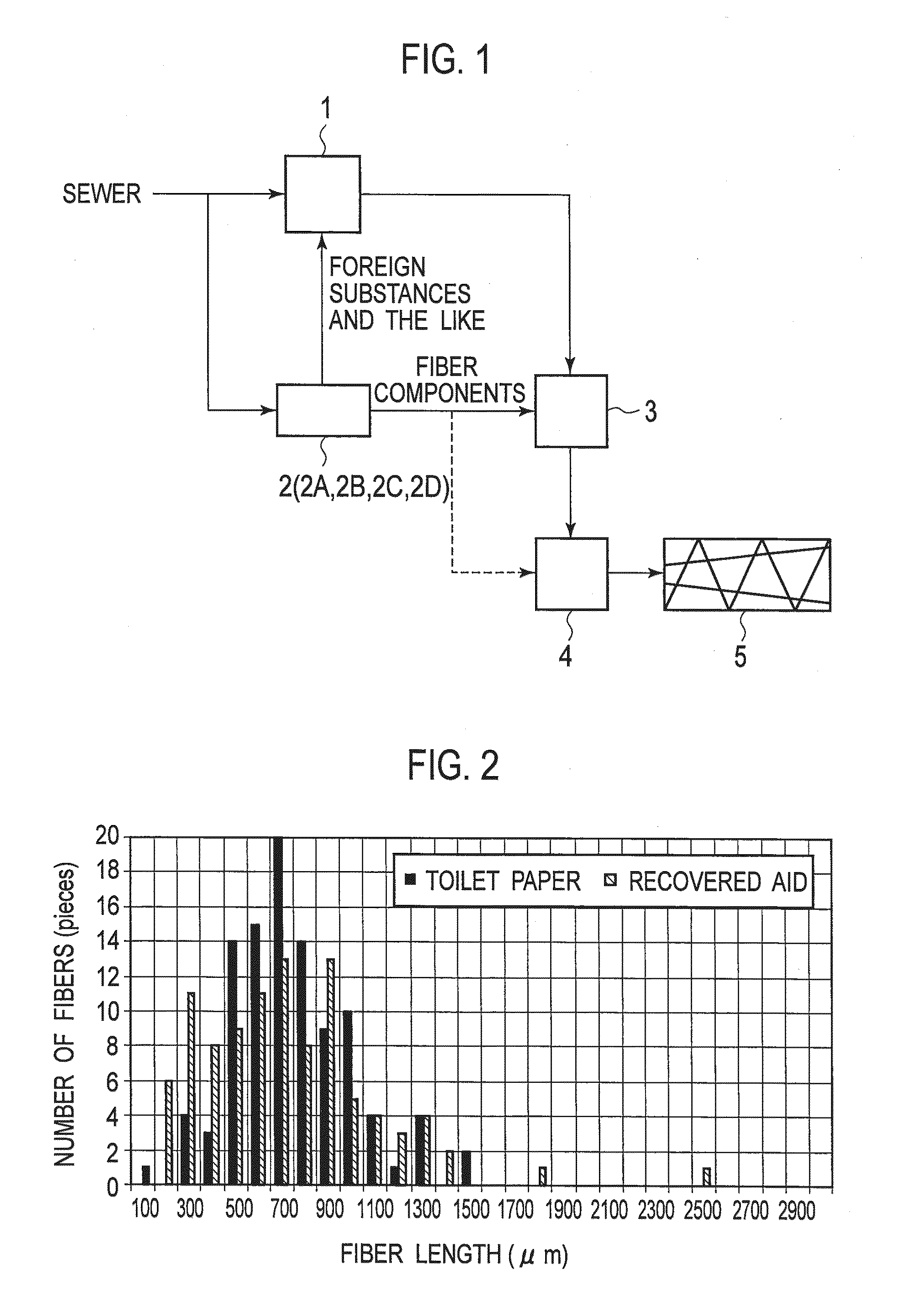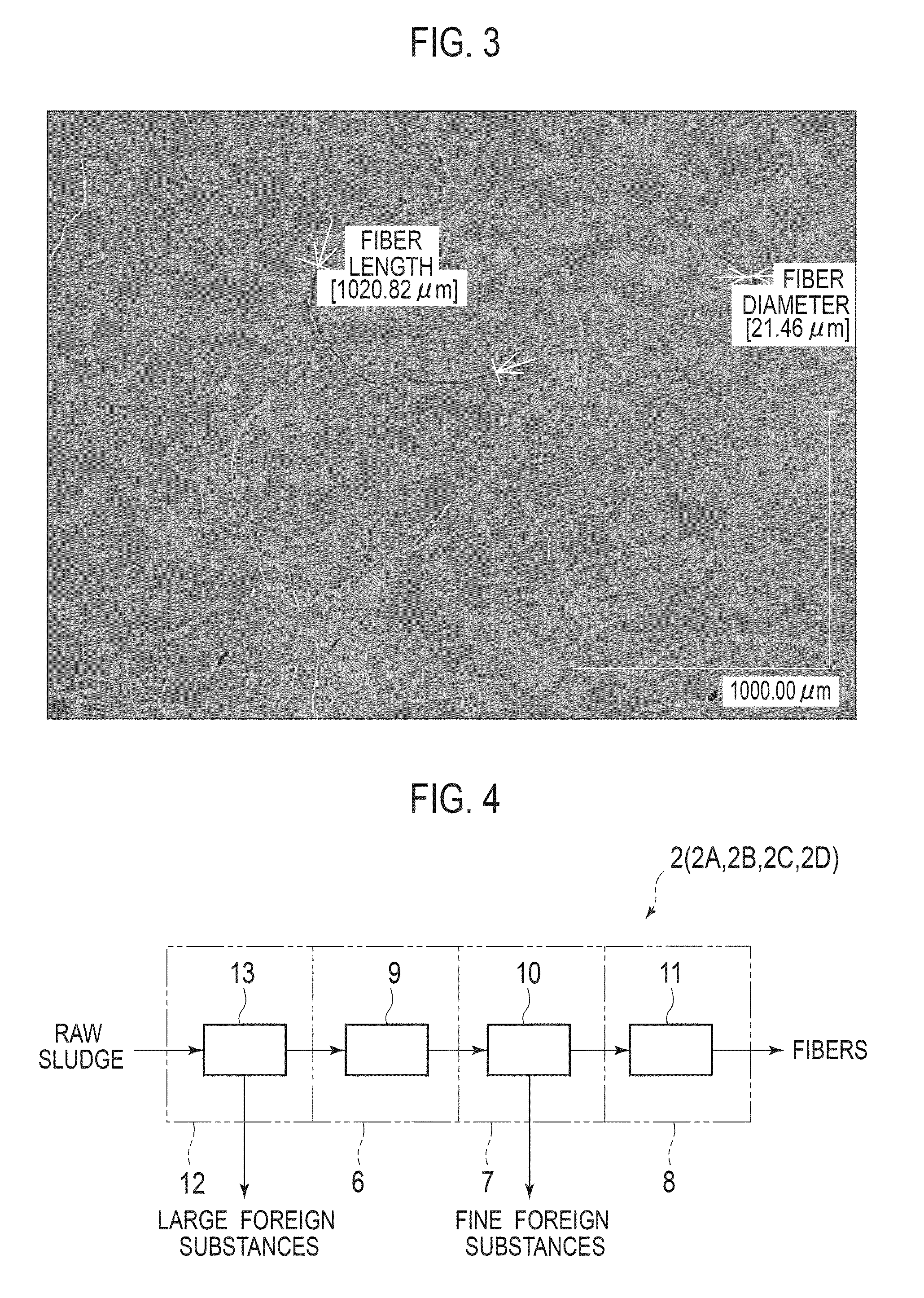Sludge dehydration system and sludge dehydration method
a technology of sludge dehydration system and sludge dehydration method, which is applied in the direction of multi-stage water/sewage treatment, separation process, filtration separation, etc., can solve the problems of poor dewatering, low fiber content of sludge generated in sewage treatment plants or the like, and inability to appropriately flocculate sludge containing reduced fiber components, etc., to achieve improved decomposition efficiency in digester tank, stable low water conten
- Summary
- Abstract
- Description
- Claims
- Application Information
AI Technical Summary
Benefits of technology
Problems solved by technology
Method used
Image
Examples
first embodiment
[0093]First, the present invention will be described.
[0094]A recovery device 2 used in a method of recovering fibers from sludge, a sludge dehydration system, and a sludge dehydration method according to the first embodiment is intended for use in a sewage treatment plant or the like. The recovery device 2 extracts specific fibrous matter from sludge (including sewage) in an earlier stage of a treatment plant, and adds the fibrous matter as a dewatering aid at the time of dewatering difficult-to-dewater sludge generated in a later stage of the treatment plant, thus improving the dewaterability of difficult-to-dewater sludge. Difficult-to-dewater sludge means sludge which exhibits poor dewaterability due to a great reduction in the content of fiber components acting as flocculation nuclei caused by biological treatment or the like. For example, digested sludge produced in a digester tank 15, OD sludge produced in a reaction tank of an OD process (oxidation ditch system), and the like...
second embodiment
[0152]Next, the present invention will be described.
[0153]In a sludge dehydration system and a sludge dehydration method according to the second embodiment, a dewaterer for dewatering supplied sludge is used. Fiber components recovered from sewage flowing into the sewage treatment plant are added to treatment target difficult-to-dewater sludge to improve dewaterability. Sewage which has just flown into the sewage treatment plant is rich in fiber components. Fiber components having properties such as predetermined lengths and diameters are recovered from the sewage to be added to difficult-to-dewater sludge. This contributes to the flocculation of difficult-to-dewater sludge, and improves the dewaterability of difficult-to-dewater sludge.
[0154]As described previously, difficult-to-dewater sludge means sludge which exhibits poor dewaterability due to a great reduction in the content of fiber components acting as flocculation nuclei caused by biological treatment or the like. For examp...
third embodiment
[0191]Next, the present invention will be described.
[0192]In a sludge dehydration system and a sludge dehydration method for sewage sludge according to the third embodiment, the total recovery amount TCA of a dewatering aid recovered from sludge (including sewage) generated in a sewage treatment process in a predetermined period CP is predicted, the total sludge amount TSA in a dewatering process is predicted, and the predicted total recovery amount PTCA is distributedly added according to the predicted total sludge amount PTSA. Thus, the stored amount of the dewatering aid is reduced to a minimum while the dewaterability of sludge is improved.
[0193]FIG. 19 is a diagram showing a sludge dehydration system and the flow of the sludge dehydration method for sewage sludge according to the third embodiment. This sludge dehydration system includes a primary sedimentation tank 201 for separating influent water flowing into the sewage treatment plant, a reaction tank 202 for clarifying orga...
PUM
| Property | Measurement | Unit |
|---|---|---|
| diameters | aaaaa | aaaaa |
| lengths | aaaaa | aaaaa |
| length | aaaaa | aaaaa |
Abstract
Description
Claims
Application Information
 Login to View More
Login to View More - R&D
- Intellectual Property
- Life Sciences
- Materials
- Tech Scout
- Unparalleled Data Quality
- Higher Quality Content
- 60% Fewer Hallucinations
Browse by: Latest US Patents, China's latest patents, Technical Efficacy Thesaurus, Application Domain, Technology Topic, Popular Technical Reports.
© 2025 PatSnap. All rights reserved.Legal|Privacy policy|Modern Slavery Act Transparency Statement|Sitemap|About US| Contact US: help@patsnap.com



